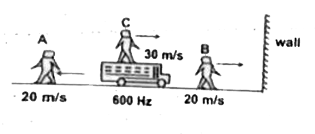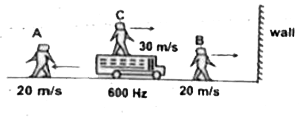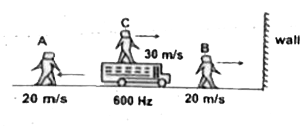Two persons A and B , each carrying a source of frequency 300HZ , are standing a few metre apart. A starts moving towards B with velocity 30m/s . If speed of sound is 300m/s , which of the following is true?
(a) Number of beats heard by A is heigher than that heard by B
(b) The number of beats heard by B are 30HZ
Both (a) and (b) are correct
Both (a) and (b) are wrong
The correct Answer is:D
To solve the problem, we need to analyze the situation using the Doppler effect for sound waves. We have two observers, A and B, with A moving towards B.
1. Identify the Given Information:
- Frequency of the sound source (f) = 300 Hz
- Speed of sound (v) = 300 m/s
- Speed of observer A (v_o) = 30 m/s
- Observer B is stationary (v_s = 0).
2. Calculate the Apparent Frequency for Observer A:
- Since A is moving towards B, we can use the Doppler effect formula:
fA=f×v+vov−vs
- Here, vs=0 (B is stationary), so the formula simplifies to:
fA=f×v+vov
- Substituting the values:
fA=300×300+30300=300×330300=330Hz
3. Calculate the Apparent Frequency for Observer B:
- Observer B hears the sound from A, who is moving towards him. Therefore, we use the formula:
fB=f×v+vsv−vo
- Here, vs=0 (A is the source), so the formula simplifies to:
fB=f×vv−vo
- Substituting the values:
fB=300×300300−30=300×300270=333.33Hz
4. Calculate the Beat Frequency:
- The beat frequency is the difference between the frequencies heard by A and B.
- For A, the frequency heard is fA=330Hz and for B, it is fB=333.33Hz.
- Therefore, the number of beats heard by A:
BeatsA=fA−f=330−300=30Hz
- And the number of beats heard by B:
BeatsB=fB−f=333.33−300=33.33Hz
5. Conclusion:
- A hears 30 beats per second and B hears 33.33 beats per second.
- Thus, the statement "Number of beats heard by A is higher than that of B" is incorrect.
- The statement "Number of beats heard by B are 30 Hz" is also incorrect.
- Therefore, both A and B are correct in their respective observations.
- Frequency of the sound source (f) = 300 Hz
- Speed of sound (v) = 300 m/s
- Speed of observer A (v_o) = 30 m/s
- Observer B is stationary (v_s = 0).
- Since A is moving towards B, we can use the Doppler effect formula:
fA=f×v+vov−vs
- Here, vs=0 (B is stationary), so the formula simplifies to:
fA=f×v+vov
- Substituting the values:
fA=300×300+30300=300×330300=330Hz
- Observer B hears the sound from A, who is moving towards him. Therefore, we use the formula:
fB=f×v+vsv−vo
- Here, vs=0 (A is the source), so the formula simplifies to:
fB=f×vv−vo
- Substituting the values:
fB=300×300300−30=300×300270=333.33Hz
- The beat frequency is the difference between the frequencies heard by A and B.
- For A, the frequency heard is fA=330Hz and for B, it is fB=333.33Hz.
- Therefore, the number of beats heard by A:
BeatsA=fA−f=330−300=30Hz
- And the number of beats heard by B:
BeatsB=fB−f=333.33−300=33.33Hz
- A hears 30 beats per second and B hears 33.33 beats per second.
- Thus, the statement "Number of beats heard by A is higher than that of B" is incorrect.
- The statement "Number of beats heard by B are 30 Hz" is also incorrect.
- Therefore, both A and B are correct in their respective observations.
Topper's Solved these Questions
- BOOK - DC PANDEY ENGLISHCHAPTER - SOUND WAVESEXERCISE - Level 1 Subjective45videos
SOUND WAVES
- BOOK - DC PANDEY ENGLISHCHAPTER - SOUND WAVESEXERCISE - Subjective Questions1videos
SOUND WAVES
- BOOK - DC PANDEY ENGLISHCHAPTER - SOUND WAVESEXERCISE - Level 1 Assertion And Reason10videos
SOUND WAVES
- BOOK - DC PANDEY ENGLISHCHAPTER - SOLVD PAPERS 2017 NEET, AIIMS & JIPMEREXERCISE - Solved paper 2018(JIPMER)38videos
SOLVD PAPERS 2017 NEET, AIIMS & JIPMER
- BOOK - DC PANDEY ENGLISHCHAPTER - SUPERPOSITION OF WAVESEXERCISE - Level 2 Subjective8videos
SUPERPOSITION OF WAVES
Similar Questions
A source of sound of frequency 500 Hz is moving towards an observer with velocity 30 m/s . The speed of sound is 330 m/s . the frequency heard by the observer will be
View SolutionTwo tuning forks A and B having a frequency of 500 Hz each are placed with B to the right of A. An observer in between the forks in moving towards B with a speed of 25 m/s. The speed of sound is 345 m/s and the wind speed is 5 m/s from A to B. Calculate the difference in the two frequencies heard by observer.
View SolutionA man standing on a platform hears the sound of frequency 604 Hz coming from a frequency 550 Hz from a train whistle moving towards the platform. If the velocity of sound is 330 m/s, then what is the speed of train?
View SolutionAn observer moves on the same line on which two sources of sound of frequency 660Hz are present. The observer observes beat frequency of 10Hz. If speed of sound is 300m/s then speed of the observer is:
View SolutionA source of sound which emitting a sound of frequency 600 Hz is moving towards a wall with a velocity 30 m/s. Three observes A, B, C moving with velocity 20 m/s, A away from the wall and B towards the wall and Inside the source, Velocity of sound in air is 330 m/s.

Find the frequency of reflected sound observed by observer BView SolutionA source of sound which emitting a sound of frequency 600 Hz is moving towards a wall with a velocity 30 m/s. Three observes A, B, C moving with velocity 20 m/s, A away from the wall and B towards the wall and Inside the source, Velocity of sound in air is 330 m/s.

Find the frequency of direct sound observed by observer AView SolutionA source of sound which emitting a sound of frequency 600 Hz is moving towards a wall with a velocity 30 m/s. Three observes A, B, C moving with velocity 20 m/s, A away from the wall and B towards the wall and Inside the source, Velocity of sound in air is 330 m/s.

Frequency of directed sound observer by observer C.View Solution
A stationary observer receives a sound from a sound of freqeuency v0 moving with a constant velocity vS=30ms The apparent frequency varies with time as shown in figure. Velocity of sound v=300ms. Then which of the following is incorrect?View Solution
A stationary observer receives a sound from a sound of freqeuency v0 moving with a constant velocity vS=30ms The apparent frequency varies with time as shown in figure. Velocity of sound v=300ms. Then which of the following is incorrect?View SolutionA tuning fork of frequency 256hZ is moving towards a well with a velocity of 5m/s . If the speed of sound is 330m/s , then the number of beats heard per second by a stationary observer lying between tuning fork and the well is
View Solution

